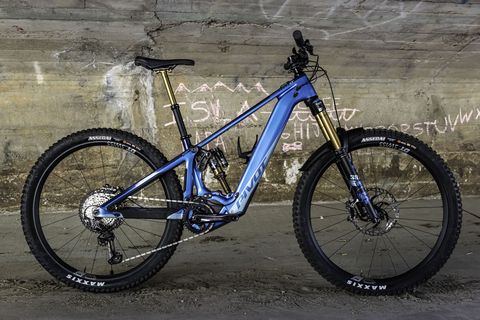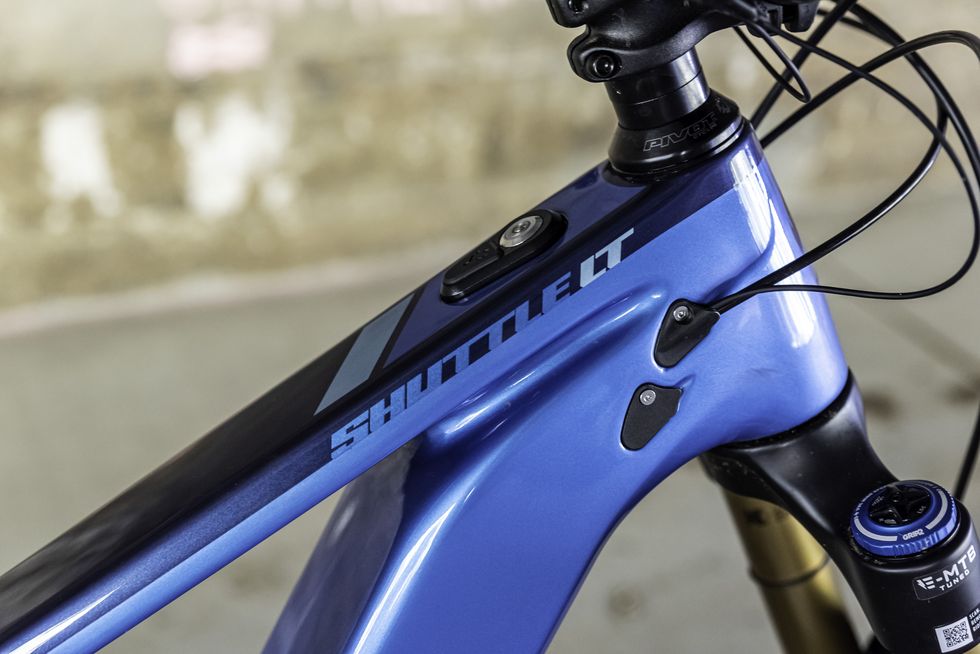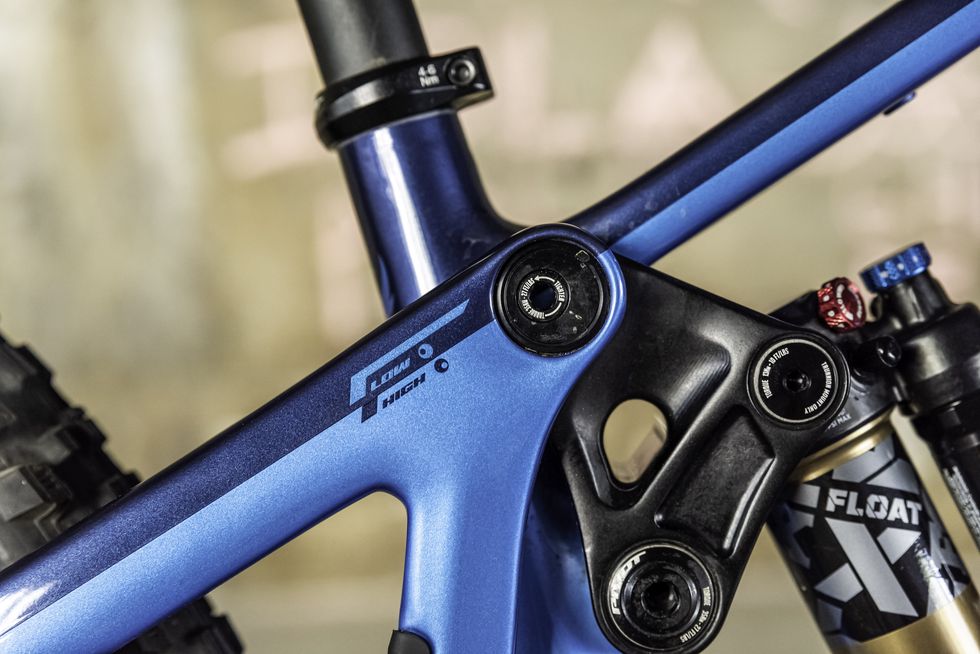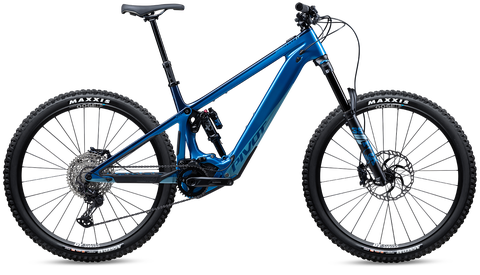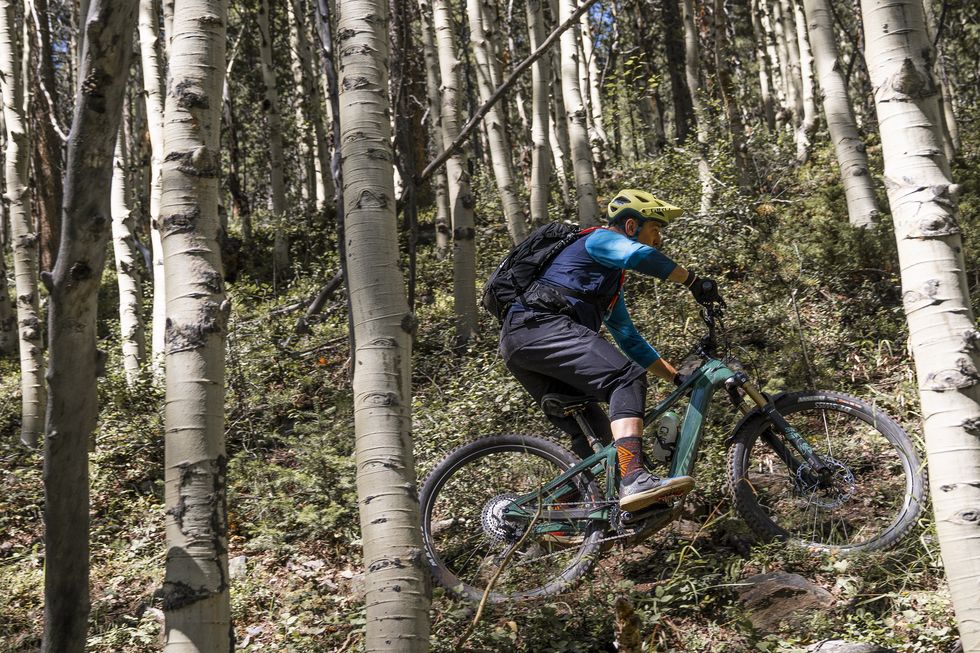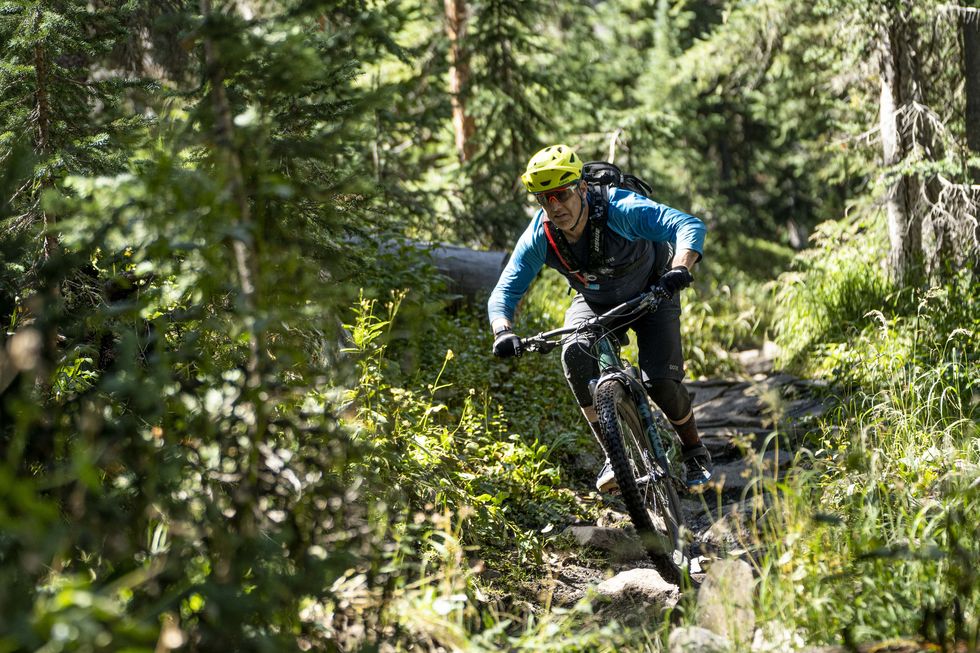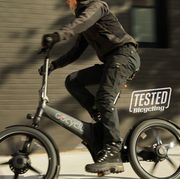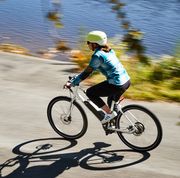The Takeaway: The Shuttle LT is an uncommonly maneuverable long-travel e-mountain bike.
- Pivot’s longest travel e-bike: 160mm rear travel and 170mm fork
- Largest battery available in any Pivot e-bike: 756Wh
- New frame design with vertical shock placement
Weight: 49.8 lb. (medium Team XTR, claimed)
Price: $9,899 (Ride XLX/XT), $11,999 (Team XTR)
The first Pivot Shuttle, launched in 2017, was a radical bike for the time. It was among the first carbon full suspension e-bikes with an integrated battery. It was light, had great suspension, and did not look like any other bike.
In 2017 the e-bike market in the United States was much different than it is today. Though their popularity was surging in Europe, the e-mountain bike boom had not hit the States yet and there was skepticism about their potential for growth on this side of the Atlantic. So, Pivot’s decision to sell that first Shuttle only in Europe did not, at the time, raise many eyebrows.
Things are much different in 2022. Pivot’s e-mountain bike offerings reflect the bikes' continued popularity in Europe and the explosive growth of e-MTBs on this side of the pond. Shuttle is now a three bike line, all available in America.
The original Shuttle carries forward as the Shuttle AM and is now the middle child of the line. The platform's (which has seen several updates over the years) frame shaping and suspension layout harken back to the Shuttle from 2017. It has 140mm of rear wheel travel with a 160mm travel Fox 38 fork, a Shimano EP8 motor, and a 726Wh battery.
The Shuttle SL is one of two new e-bike models from Pivot. This is Pivot’s light, lower-powered, and shorter-travel e-bike offering (along the lines of the Orbea Rise, Specialized Levo SL, and Trek Fuel EX-e). The SL features a sleeker, crisper frame shape compared to the original Shuttle, and has vertical shock placement. The bike has 132mm rear travel with a 150mm or 140mm fork, a Fazua Ride 60 motor, and a 430Wh battery.
Rounding out the Shuttle line is the newest model, the Shuttle LT. Patterned after Pivot’s Firebird enduro bike, the LT is its biggest travel e-bike. The Shuttle LT has the styling and shock position of the SL but features 160mm rear travel with a 170mm fork, Shimano’s EP8 motor, and a 756Wh battery.
Pivot Shuttle LT—Details
Pivot took the design language of its recent models and applied it to its newest e-bike. Compared to the original Shuttle, the LT (and the SL) frame features straighter lines and squarer tube shapes, while the shock rotates about 90 degrees into a nearly vertical position.
Pivot says the vertical shock yields a stiffer and lighter frame, better standover height, and a more progressive shock rate than the horizontal shock position of the original Shuttle. The LT’s frame looks smaller and sleeker. The main triangle is noticeably more open with room for both a water bottle and an accessory mount under the top tube.
Aiding the execution of this new frame design is a more compact battery capsule. Drawn up by Pivot’s engineering team (and executed by Darfon), the battery sits as low as possible in the frame. The front of the Shimano EP8 motor is raised to allow the battery to slide out from below. This battery is designated “Shimano Certified”, meaning all warranty issues are handled directly by Shimano.
Like all Pivot full suspension frames since the brand’s inception in 2007, the Shuttle LT uses dw-link short dual-link suspension. Pivot equips their bikes with Fox suspension exclusively. However, the LT uses a standard-sized shock (205mm x 65mm trunnion mount) and is designated coil-over compatible, so riders can change to a different shock if they want.
Although Pivot only sells the Shuttle LT with matching 29-inch wheels, the brand has okayed the bike for mixed-wheel size use. Riders will need a new rear wheel—with super boost (157mm) hub spacing—and tire (2.6” recommended) of course, and the brand recommends setting the LT’s flip chip in the high position to correct the geometry for the wheel size change.
Rounding out the list of notable details: Four frame sizes (small through extra-large), two colors (blue or green), internal hose and housing routing with Pivot’s clamping ports, rubber chain slap protectors, a burly downtube protector, an integrated upper chain guide, top tube power switch with integrated USB-C port (to charge a phone or GPS unit), and a 330lb. weight limit.
Pivot Shuttle LT—Geometry
Like all recent Pivot models, the Shuttle LT features a lengthy cockpit. Other details include low-top tubes for generous standover clearance and short and straight seat tubes. Taken together, many riders in the middle of the height curve can size the Shuttle LT by length and feel.
For example, I am 5'8" and usually ride a medium frame size, even in recent Pivot models. But for my first ride on the Shuttle LT, I sampled a small, and the fit and feel were great. This is not a surprise when you look a the numbers. The small LT’s 445mm reach and 605mm top tube lengths are in line with some size medium/mid-sized trail bikes—a Transition Sentinel in a medium has 450 mm reach and a 585mm long top tube—so even though the LT I rode was a “small” size the dimensions lined up with my preferences.
While the sizing works well for medium and taller-height riders, shorter riders may feel overlooked as the small LT is quite long. Pivot countered that the small-size LT is the smallest they can make a bike with 29-inch wheels and a 756Wh battery. They also pointed to the small LT’s standover (686mm), and short seat tube (370mm) as significant improvements to the Shuttle AM’s numbers. And based on a quick survey of notable competitors, the Shuttle LT does have the shortest standover and seat tube in its class.
Pivot Shuttle LT—Builds and Prices
The Shuttle LT launches with two build options; both use the same motor, battery, and carbon frame.
Ride SLX/XT—$9,900
- Fox Float X Performance shock
- Fox 38 GRIP Performance E-MTB fork
- Shimano SLX shifter, XT rear derailleur
- Shimano Deore 10-51T cassette, EM600 cranks (160mm)
- Shimano SLX brakes, Galfer rotors (223mm front, 203mm rear)
- e.thirteen Vario dropper post
- DT Swiss H1900 wheels
- Maxxis Assegai EXO+ 2.5” tires
Team XTR—$12,000
- Fox Float X Factory shock
- Fox 38 GRIP2 Factory E-MTB fork
- Shimano XTR shifter and rear derailleur
- Shimano XT 10-51T cassette and cranks (160mm)
- Shimano XTR brakes, Galfer rotors (223mm front, 203mm rear)
- Fox Transfer Factory dropper post
- DT Swiss HX1501 wheels
- Maxxis Assegai EXO+ 2.5” tires
Pivot Shuttle LT—First Ride
I traveled to Salida, Colorado to take a first ride on the Shuttle LT. After being shuttled—yes, I got a shuttle to ride the Shuttle—to the top of Monarch Pass, I rode a section of the Monarch Crest trail before dropping down Green's Creek. With about 4,500 feet of descending but just 700 feet of climbing, the ride hardly taxed the motor and battery. I used Boost and Trail modes the entire ride, and by the end of the ride was only down one battery nugget on the Shimano display. But, the ride was long enough to glean a few initial impressions of the Shuttle LT. A long-term test bike is on the way to me so that I can ride the bike on more familiar trails for a more detailed review.
I have spent time on many long-travel, full-power e-bikes. Bikes like the SCOR 4060 LT (and ST) Z, Specialized Levo and Kenevo, Santa Cruz Heckler, Trek Rail, Yeti 160-E, Evil Epocalypse, Canyon Spectral:ON, and Mondraker Crafty are all good in their own ways. What sticks with me most about my ride on the Shuttle LT is this e-bike's agile and maneuverable feeling. The Shuttle LT's travel and weight are in-line with the bikes mentioned above, but I have never been as comfortable on a full-power e-bike as I have on this bike. On big e-bikes, I usually feel a bit like I am along for the ride (with the best way to ride these beasts being to point them in the approximate direction I want to go and hang on.)
After a little saddle time and suspension fettling, I did not have that sensation on the LT. For sure it is a long-travel and heavy e-bike, but I felt like I could toss it around, finesse it, and be more precise with it than I could on any other bike in the class. The Shuttle LT is a full-power e-bike I can almost ride like I do an unpowered bike.
Riding the small LT might play a role here, but not the only factor. The small Shuttle LT is dimensionally similar to the medium Santa Cruz Heckler MX. The small LT has a longer wheelbase and slacker head tube angle than the medium Heckler, yet the Shuttle LT felt faster, smoother, more reactive, and more tossable than the Heckler. Only Evil’s Epocalypse sticks in my head as being close to the Shuttle LT’s precision and flickable feel. I do not find this surprising as Evil and Pivot have Dave Weagle-designed suspension and a handling philosophy that bends to the quicker side of the spectrum.
One ride is not enough time for me to dial in a bike, and I did not get familiar with the bike’s character. Even so, I felt more comfortable and confident, more quickly, on the LT than on any e-mountain bike I have yet ridden. It feels freakin' dialed in. Plus, it has one of the best e-bike motors going and a generously sized battery.
The e-mountain bike landscape has changed a lot since 2017, but one thing remains: Pivot’s Shuttle is one of the best.

A gear editor for his entire career, Matt’s journey to becoming a leading cycling tech journalist started in 1995, and he’s been at it ever since; likely riding more cycling equipment than anyone on the planet along the way. Previous to his time with Bicycling, Matt worked in bike shops as a service manager, mechanic, and sales person. Based in Durango, Colorado, he enjoys riding and testing any and all kinds of bikes, so you’re just as likely to see him on a road bike dressed in Lycra at a Tuesday night worlds ride as you are to find him dressed in a full face helmet and pads riding a bike park on an enduro bike. He doesn’t race often, but he’s game for anything; having entered road races, criteriums, trials competitions, dual slalom, downhill races, enduros, stage races, short track, time trials, and gran fondos. Next up on his to-do list: a multi day bikepacking trip, and an e-bike race.

